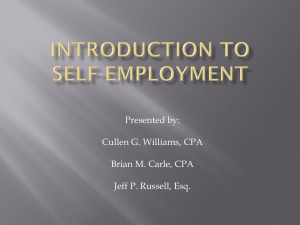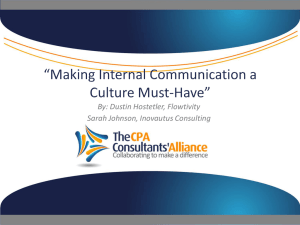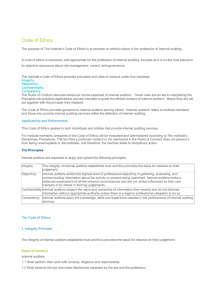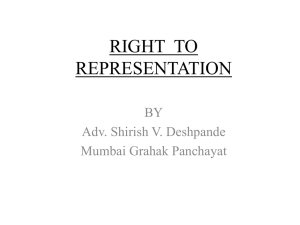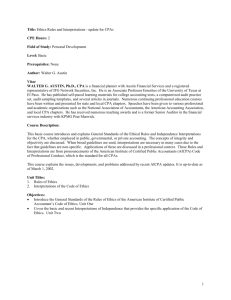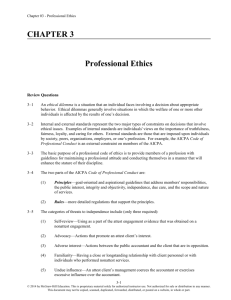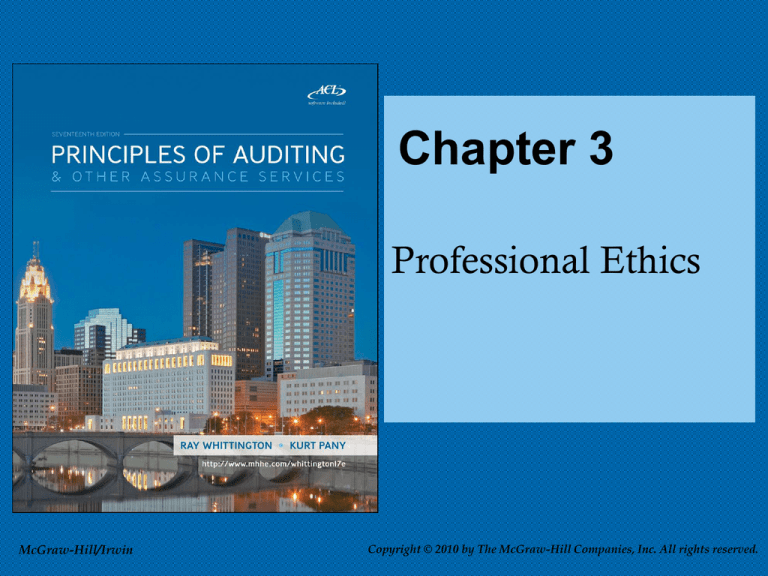
Chapter 3
Professional Ethics
McGraw-Hill/Irwin
Copyright © 2010 by The McGraw-Hill Companies, Inc. All rights reserved.
3-2
Steps in Resolving an Ethical Dilemma
Identify
the problem
Identify possible courses of action
Identify any constraints relating to the
decision
Analyze the likely effects of the possible
courses of action
Select the best course of action
3-2
Need for Professional Ethics
Responsibility
CPA is representative of the public
Complex
body of knowledge
Abundance of authoritative pronouncements
Standards
of Admission to the Profession
Min. standards for education and experience
Need
to serve the public
for public confidence
CPA product is credibility
3-3
Code of Professional Conduct
Designed
to provide a framework for
expanding professional services and
responding to changes in the profession
Two sections
Principles
Rules
Additional
guidance
Interpretations
Ethics Rulings
3-4
AICPA Professional Ethics
3-5
Principles of the Code
Responsibilities
The
Public Interest
Integrity
Objectivity and Independence
Due Care
Scope and Nature of Services
3-6
The Rules of the AICPA Code of
Professional Conduct
Rule
101
102
201
202
203
301
302
501
502
503
504
505
Title
Independence
Integrity and Objectivity
General Standards
Compliance with Standards
Accounting Principles
Confidential Client Information
Contingent Fees
Acts Discreditable
Advertising and Other Forms of Solicitation
Commissions and Referral Fees
(Deleted)
Form of Organization and Name
3-7
Independence
Independence
of mind (actual
independence)
Independence of appearance
Both are required.
3-8
AICPA Conceptual Framework
for Independence
The AICPA Conceptual Framework for
Independence is used to evaluate threats to
independence. When a threat arises, the
approach considers
Whether the Code directly addresses the threat
If the Code does not directly address the threat, the
auditor considers whether adequate safeguards exist
to eliminate the threat to independence
The perspective used throughout is whether a
reasonable person, aware of all the relevant
facts would conclude that an unacceptable risk
of non-independence exists.
3-9
3-10
Threats to Independence
(and an example of each)
Self-Review—CPA firm has provided consulting
services that relate to audit
Advocacy of client—CPA promotes client securities as
part of an initial public offering
Adverse Interest— Litigation between client and CPA
firm
Familiarity—Spouse holds a key position with client
Undue Influence--Pressure from client to reduce audit
procedures
Financial Self-Interest of CPA—CPA owns stock in the
client
Management Participation—CPA Serves as officer of
client
3-10
Independence Safeguards
Created
by profession, legislation or
regulation (e.g., education requirements)
Implemented by attest client (e.g.,
effective board of director oversight)
Put in place by CPA firm (e.g., stressing
importance of independence)
3-11
Summary of Conceptual Framework Approach for
Evaluating Threats to Independence (Figure 3.4)
3-12
Covered Members
Interpretation 1 of Rule 101 is particularly important for
understanding independence. It relies in part on the concept of
a “covered member.”
Covered Members include
Staff working on the attest engagement
An individual who may influence the attest engagement
A partner in the office in which the partner in charge of the attest
engagement primarily practices
Partners or managers that provide a specified amount of
nonattest services to client
The public accounting firm and its employee benefit plan
Any entity controlled by one or more of the above
3-13
Interpretation 101-1 States That
Independence is Impaired if a Member:
Section
A. Has direct or material indirect financial
interest, loan, or joint business investment; trustee or administrator of estate
or trust that has such interest
Applies to:
Covered Members
B. Owns 5% or more of client’s outstanding
equity or other ownership interest
All Partners and
Professional Staff
C. Simultaneously associated with client as
director, officer, employee, etc.
All Partners and
Professional Staff
3-14
Financial Interests from
Interpretation 101-1
Example
Direct
Indirect
Investment in client,
such as owning
capital stock or
providing a loan
Investment in a
mutual fund, which
in turns owns
capital tock of a
client
Type allowed
for individual None
CPA to retain
independence
Immaterial
3-15
Figure 3.5 – The effects of partner and professional staff
relationships on firm independence*
3-16
Figure 3.6 Effects of Interests of Family Members,
Relatives and Friends
3-17
Consulting Services Prohibited by
the Sarbanes-Oxley Act
Bookkeeping
Financial systems design and Implementation
Appraisal or valuation services
Actuarial services
Internal audit outsourcing
Management functions or human resource
services
Investment services
Legal services and expert services
Certain tax services
3-18
Rule 102
Rule
102 – Integrity and Objectivity
Applies to all members of the AICPA and to all
services provided by CPAs
Violations
• Makes, or permits or directs another to make, materially
incorrect entries in a client’s financial statements or records
• Fails to correct financial statements that are materially false
or misleading when member has such authority
• Signs, or permits or directs another to sign, a document
containing materially false and misleading information
3-19
Rule 201
Rule
201 – General Standards
Apply to all CPA services
Member shall comply with following
standards:
•
•
•
•
Professional competence
Due Professional Care
Planning and Supervision
Sufficient Relevant Data
3-20
3-21
Rule 202 Standards
Standards
Technical Body
Auditing Standards Board
(ASB)
Management Consulting
Services Executive
Committee (MCSEC)
Accounting and Review
Services Committee (ARSC)
ASB, MCSEC, and ARSC
FASB, GASB and FASAC
Statements on Auditing
Standards
Statements on Standards for
Consulting Services
Statements on Standards for
Accounting and Review
Services
Statements on Standards for
Attestation Engagements
FASB, GASB and FASAC
Statements and related
Interpretations
3-21
Rule 203
Accounting
Principles
Designates GAAP
The Statements and Interpretations of
• FASB
• GASB
• FASAB
3-22
Rule 301
Confidential
Client Information
A member in public practice shall not disclose
any confidential client information without the
specific consent of the client.
Auditors cannot directly disclose illegal acts
by the client unless they have a legal duty to
do so
Confidential but not privileged
communications with client
3-23
Rule 302 –
Allowable Contingent Fees
Allowable for clients for which the CPA provides none
of the following services:
An audit or review of financial statements
A compilation of financial statements expected to be used by
a third party and does not disclose a lack of independence
An examination of prospective financial information
Contingent fees are not allowed to prepare an
original or amended tax return or claim for tax refund
(Note: All tax contingent fees are prohibited under
PCAOB Standards)
3-24
Rule 501
Retaining client records may be considered an
act discreditable to the profession
Rules:
Client prepared records—should always be returned to the
client.
Client records prepared by the CPA (e.g. payroll records)—
should be provided to client, except they may be withheld if they
are incomplete or fees are due for them.
Supporting records (e.g., adjusting entries)—should be
provided to client, but may be withheld if fees are due for them.
CPA working papers (e.g., audit programs)—CPA’s property
and need not be provided to client , unless required by law.
3-25
Rules 502, 503, 505
Rule 502 – Advertising
May advertise as long as it is not false, misleading or
deceptive
Rule 503 – Commissions
Allowable commissions received must be disclosed to
the client
Rule 505 – Form of Organization & Name
Can practice in any legal business form
Allows fictitious names as long as not false,
misleading or deceptive
3-26
Figure 3.9 –
Alternative Practice Structures
3-27
IIA Code of Ethics--Principles
Internal auditors are expected to apply & uphold the following principles:
Integrity. The integrity of internal auditors establishes trust and
thus provides the basis for reliance on their judgment.
Objectivity. Internal auditors exhibit the highest level of
professional objectivity in gathering, evaluating, and communicating information about the activity or process being examined.
Internal auditors make a balanced assessment of all the relevant
circumstances and are not unduly influenced by their own interests
or by others in forming judgments.
Confidentiality. Internal auditors respect the value and ownership
of information they receive and do not disclose information without
appropriate authority unless there is a legal or professional obligation to do so.
Competency. Internal auditors apply the knowledge, skills, and
experience needed in the performance of internal auditing services.
3-28
IIA Code of Ethics—
Rules of Conduct
1. Integrity; Internal auditors:
.1 Shall perform their work with honesty, diligence,
and responsibility.
.2 Shall observe the law and make disclosures
expected by the law and the profession.
.3 Shall not knowingly be a party to any illegal
activity, or engage in acts that are discreditable to
the profession of internal auditing or to the
organization.
.4 Shall respect and contribute to the legitimate and
ethical objectives of the organization.
3-29
IIA Code of Ethics—
Rules of Conduct
2. Objectivity; Internal Auditors:
.1 Shall not participate in any activity or relationship
that may impair or be presumed to impair their
unbiased assessment. This participation includes
those activities or relationships that may be in
conflict with the interests of the organization.
.2 Shall not accept anything that may impair or be
presumed to impair their professional judgment.
.3 Shall disclose all material facts known to them
that, if not disclosed, may distort the reporting of
activities under review.
3-30
IIA Code of Ethics—
Rules of Conduct
3. Confidentiality; Internal auditors:
.1 Shall be prudent in the use and protection
of information acquired in the course of their
duties.
.2 Shall not use information for any personal
gain or in any manner that would be
contrary to the law or detrimental to the
legitimate and ethical objectives of the
organization.
3-31
IIA Code of Ethics—
Rules of Conduct
4 Competency; Internal auditors
.1 Shall engage only in those services for which they
have the necessary knowledge, skills, and
experience.
.2 Shall perform internal auditing services in
accordance with the Standards for the Professional
Practice of Internal Auditing.
.3 Shall continually improve their proficiency and the
effectiveness and quality of their services.
3-32

